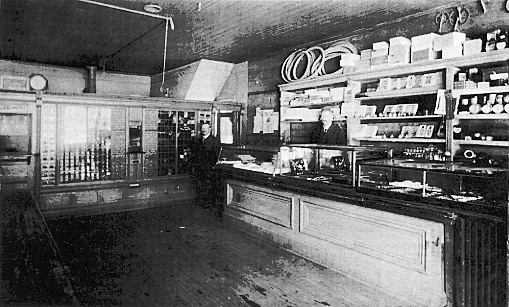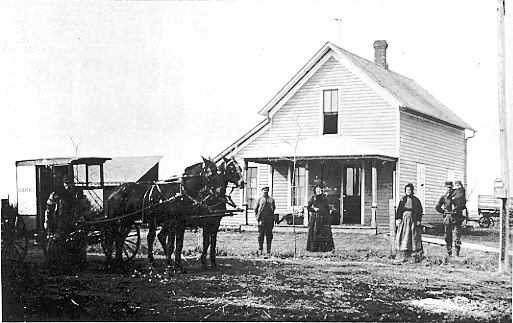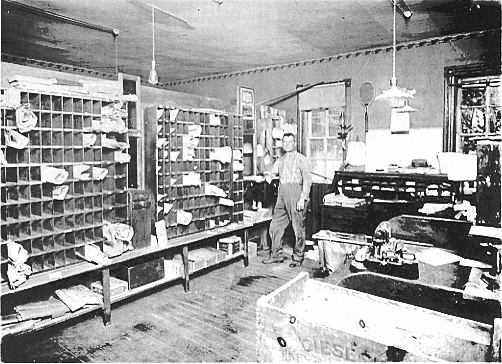|
|
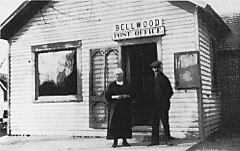
Daniel and Postmistress Minnie
Burch.
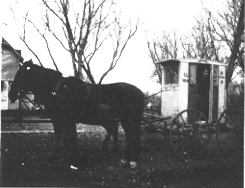
Adeline Burch delivering mail
in Bellwood.
History of
Railroad
Regarding
the history of any railroad branchline, there's usually as
many facts and/or anecdotes to relate as there are ties in
its roadbed. The 70-mile Burlington Northern Railroad
branchline from Lincoln, Nebr., to Columbus, Nebr., is no
exception.
The Columbus branchline, as it has been
referred to for years, was still 10 years away from
existence when the first train chugged into Nebraska's
capital city in July, 1870, over the Burlington and Missouri
River Railroad line from Plattsmouth. The nation had just
been linked in 1869 by the completion of the Union and
Central Pacific transcontinental railroad. Now other
railroads such as the B&M (later known as the Chicago,
Burlington and Quincy) would lay tracks across the vast
expanses that remained and make access to it by settlers
much easier than before.
Incorporated in April, 1879, and organized
that September, the Lincoln and North Western Railroad
Company was the name used in constructing the Columbus line.
Taking advantage of an apparently mild winter, track laying
commenced in Lincoln in September, 1879. The rails arrived
at the future site of Bellwood on or about Feb. 1, 1880,
having built through such towns as Milford, Seward, Ulysses
and David City. Completion of the line into Columbus was
delayed until May, 1880, as a trestle was constructed across
the Platte River. One of the first trains over the
newly-finished line was a special from Lincoln on May 18th,
carrying delegates and guests to a Republican State
Convention being held in Columbus. The line was leased to
the B&M in May, 1880, and was sold to the CB&Q in
February,
|
|
1908.
The first throaty howl of a steam
locomotive's whistle resounding over the Bellwood area
likely came from a construction supply train engine as it
followed the tracklayers over its newly-laid path. The first
names given to the townsite by the L&NW was apparently
Platte Station. The name was later changed to coincide with
a decision to name the town after local property owner Jesse
Bell. He provided the L&NW with ground on which to
construct a depot, one of the first structures erected at
Bellwood. The frame, two-story building featured a passenger
waiting room and agent's office on the first floor while
upstairs were living quarters for the agent.
About 40 homes constructed at Bellwood
during the L&NW's first five years of service
exemplified prosperity brought by the railroads. Besides the
regularly-scheduled passenger and freight trains that were
put on, special trains that rambled over the Columbus branch
were as numerous as their causes, whether it was to deliver
happy picnickers to a Chautaqua, delegates to a political
rally for William Jennings Bryan or weary soldiers home from
a war.
Situated near the Loup and Platte Rivers'
junction, the railroad crosses the Platte on a bridge which
initally provided CB&Q maintenance forces with a
seemingly annual task of repairing damage done to it by
flooding. Local newspaper subscribers became accustomed to a
sure sign of spring by reading that the Burlington's Platte
River bridge had "gone out."
The hardiness of some travelers over the
branch was noted in a March, 1905, issue of the Columbus
Telegram:
"Miss Helen Shannon returned last Saturday
from a visit with her sister in Colo. From Lincoln she came
over the Burlington line on Saturday night. Owing to the
Platte River bridge being out, the train was unable to come
any closer than Bellwood. Miss Shannon was accompanied by
her father, and in order to get home, they had to walk
across the damaged bridge, in one place of which the track
had no support underneath for a distance of several feet,
then pick their way over a field of solid ice chunks for
nearly two miles until they reached a farmer, who was
engaged to bring them to Columbus in a carriage."
The situation improved after the CB&Q
replaced its wooden trestle in the 1920's with a steel span
relocated to higher ground by having one span cross the
Platte via Buck Island.
The Burlington's most recent and serious
trouble with the bridge came with the river ice of March 28,
1960, which demolished one whole span. Train service to
Columbus was suspended for over two months until repairs
were made.
The gravel pits near the Platte River made
for some service spurs and considerable summertime business.
The most recent gravel spur north of Bellwood was
established in the late 1930's as Moll Spur. The pit is now
owned by Central Sand and Gravel Company, which utilizes its
own fleet of gravel cars. The amount of increased tonnage
from loaded Moll Spur gravel cars in recent years forces
train crews to frequently "double the hill" while traversing
the grade out of the Platte Valley between Bellwood and
David City. The crew must uncouple the front half of the
train and proceed with it to David City where it is left
while they return with the locomotives for the remaining
cars.
The machines on the Columbus branch that
hissed and hooted but still did the bidding of men in their
cabs were diminutive at the outset. Their wheel arrangement
were likely of the then-standard 4-4-0 design, consisting of
four guide wheels and four drive wheels, but no trailing
wheels. The size and power of the branch's steam locomotives
increased over the years, though the largest classes of
engines were restricted from serving on the line because of
weight limits on bridges. Railroad water towers to replenish
the engines were located at Seward, David City and Columbus.
Coal for fuel was available first at Columbus and later
David City.
Though their sounds and appearance
provided for many artistic and romantic feelings, smoke and
cinder-belching steam locomotives did have drawbacks. The
Butler County
|
|
